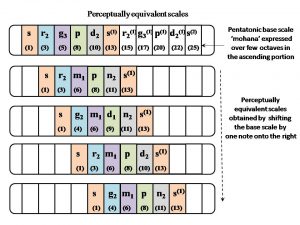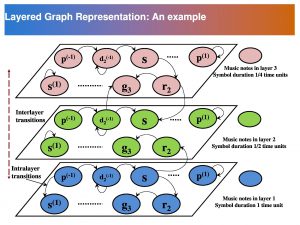MUSIC SIGNAL PROCESSING
Music is a form of art with pleasant sound and silence for communication. The core elements involved in any genre of music are melody, harmony, rhythm, dynamics, timbre and texture.
Our aim:
At PNSIL, we focus on techniques to automate musical sequences and patterns and have built the most sophisticated algorithms relating to it. The creation of these musical sequences involves splicing the notes in a constrained way resulting in aesthetically appealing patterns.
Brief history of music:
Classical Indian music has been classified into two broad genres, namely Carnatic and Hindustani. Carnatic music is widely followed by musicians in south India and Hindustani music in the northern part of India.
- Carnatic music has a fundamental set of melakarta ragas and numerous janya ragas derived from the fundamental set.
- The musical notes are considered with respective to the constraints in a musical scale for the formation of melody sequences. The interval between a musical pitch and another with half or double of its frequency forms an octave.
In Western music , each octave comprises of series of 12 notes known as semitones, which constitute a chromatic scale. Contrary to this, Arabic and Persian music comprise of quarter-tones.
Musical notes:
Indian music consists of 7 notes and 5 variant notes that correspond to 12 notes of the European chromatic scale. Based on the cardinality of notes in the ascending and descending octave, there are various melodies such as seven toned major, six toned major, pentatonic minor etc. The seven tones in Indian music corresponding to the heptatonic major scale are labeled as ‘sa’, ‘ri’, ‘ga’, ‘ma’, ‘pa’, ‘da’, ‘ni’. In the western sol-fa equivalent, they correspond to ‘do’, ‘re’, ‘mi’, ‘fa’, ‘so’, ‘la’, ‘ti’.
The ascending sequence in a typical musical scale is as follows:
The descending sequence in a typical musical scale is as follows:
1. Veena
2. Flute
3. Violin
Machine automated Carnatic music (South Indian music):
- An approach for music signal representation based on symbolic dynamics has been developed by translating the lexicographic rules over a musical scale to constraints on a Markov chain to automate music.
- The analysis of our machine automated music synthesis has been carried out by considering examples from the south Indian classical music system; however the techniques can be applied for various genres of world music. The significant features incorporated in the machine automated music synthesis are perceptual scale equivalence, emission of triad patterns, rhythm synchronization, modeling of overtones and silence.
- The applications of our music source model are in music synthesis, music content retrieval system in search engines and digital enhancement of individual source streams in music.
- To mathematically quantify user listening experience, correlation between the max-entropic rate of a musical scale and its subjective aesthetic component has been examined.
1.Shankarabharanam raaga automated (Carnatic music):
2.Mohana raaga automated (Carnatic music):
3.Automated rhythm synchronization of percussion instrument (Mridangam) played at the background of melodic instrument (Veena):
Rhythm is an important constituent of music, usually played in the background of vocal and melody sequences in a musical concert. Rhythm can be considered as the arrangement of musical beats and silences over a repeating measured time interval called a cycle.
4.Perceptual scale equivalence:
One of the intriguing aspects of music rendering during improvisation is the concept of ‘perceptual scale shifting’. Usually, a musician while rendering music sets the reference tone to ‘sa’ corresponding to the base pitch. During perceptual scale shifting, a performer can shift the reference tone from ‘sa’ to any tone ‘a’ within the scale and use the tone ‘a’ as the new reference point for the scale. This operation is essentially equivalent to shifting the original scale to start with a base pitch set equal in frequencyto tone ‘a’.

Pentatonic scale ‘mohana’ shifts to musical scale ‘hindola’:
5.Mohana raga automated with variable amplitude:
6.Pentatonic musical scale (Mohana raga) exists across the world with various names:
Gamaka modeling dataset
Gamakas are the different ornamentations that improve the melody of music. The corpus we created has monophonic audio recordings with a sampling frequency of 44.1KHz for the six gamakas used. The duration of each clip varies between 1 to 2 seconds.
Gamaka modeling dataset can be found here.
Team members
- Prof. Shayan S. Garani (Chief Investigator)
- Prof. Harish Seshadri, IISc
Publications
- Z. Sasindran and S. S. Garani, “Modeling Ornaments in Carnatic Music Signals via Wavelets”, in IEEE Asilomar Conf. on Signals, Syst., and Comput., 2020.
- S. G. Srinivasa and H. Seshadri, “Music and Symbolic dynamics: The Science behind an Art,” Info. Theory and Applications Workshop (ITA), Feb. 2013.
Journals
- S. S. Garani and H. Seshadri, “An Algorithmic Approach to South Indian Classical Music “, in J. of Math. and Music, May 2019.
Broadcast
Prapatti as envisaged by Saint Tyagaraja – Some excerpts of Prof. Shayan Srinivasa Garani broadcast over the All India Radio.
Popular web links related to Carnatic music:
- Sangita Sampradaya Pradarsini by Subbarama Dikshitar
- Thyagaraja kritis
- Shivkumar Kalyanaraman’s Carnatic music krithi audio archive
Other web links related to research on music signal processing:
- CCRMA – Stanford university
- Center for music technology – Georgia Tech
- Music, mind and machine – MIT
- Synthesis of Carnatic music tones
Note:
The database of musical tones for our automated music synthesis were synthesized from “Swar Plug” software purchased from Swar Systems company and free version of “Gaayaka” software developed by M.Subramanian.
